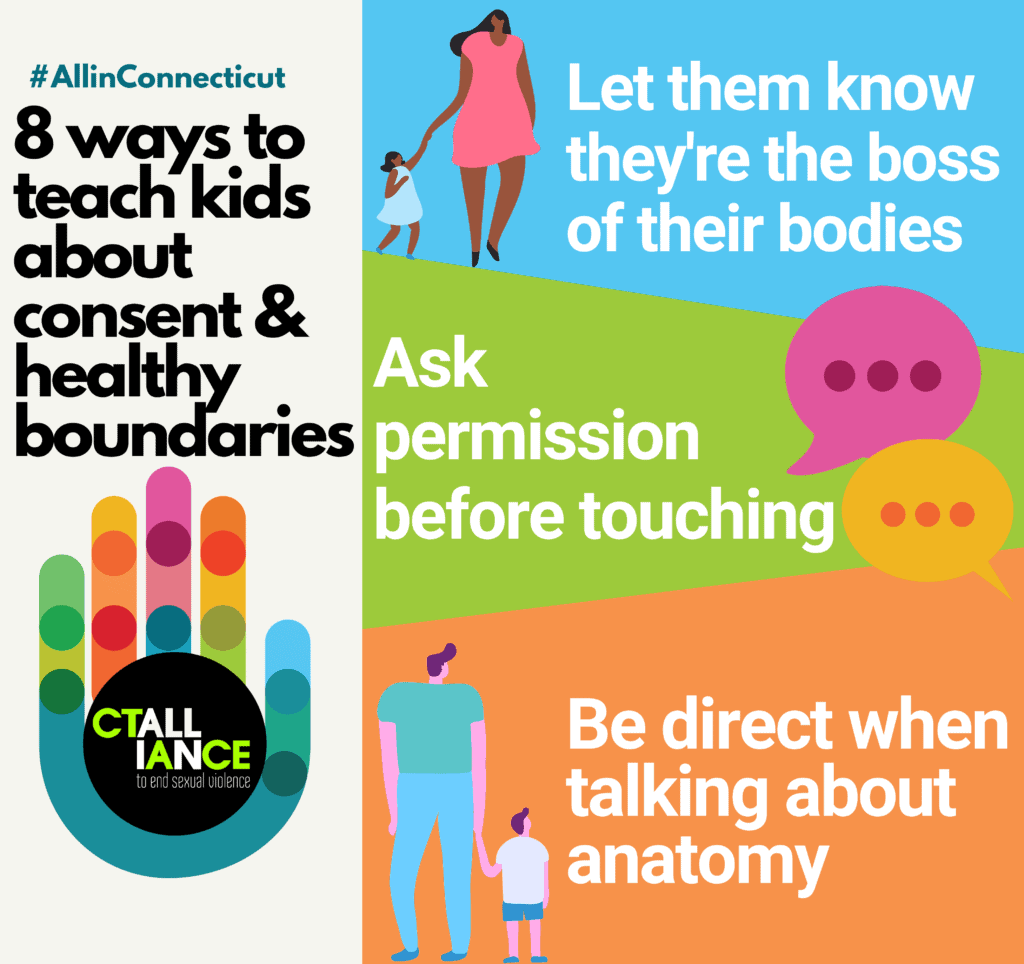Teaching bodily autonomy results in a child who is capable of setting boundaries, feels empowered to say ‘no,’ and is able to navigate a world that often does not set them up for success.
1. Let children know they’re the boss of their bodies. Emphasize and create opportunities for them to understand they’re in control of how they interact with others and how others interact with them. Never force hugs, kisses, or caresses as stand-ins for communication – even with relatives. If a child doesn’t want to hug during greetings and goodbyes, let them know that’s okay – they can wave, high-five, blow a kiss, or simply state their salutations.
2. Ask for permission before touching children and encourage them to do the same. Do this by modeling it yourself. Before you reach out for a hug from your student, child, niece, nephew or grandchild, ask permission to do so. If the child is very young, or nonverbal, get into a habit of communicating consent by simply letting them know what you’re doing, and why, before touching. Try simple explanations like: “I’m going to button up your shirt, so you’re ready for school,” or “I’m going to rub shampoo into your hair, so you’re clean.” This reinforces the concept that communication during touch is ongoing.
3. Let children know it’s okay to ask for help and help them identify ‘safe’ adults. Teach kids that safe adults listen to what they want and need, and don’t make them feel uncomfortable or scared. Identifying safe adults is difficult, even for other adults, so the key here is to find strength in numbers and have children identify numerous adults who the child feels they can freely open up to if they ever feel frightened or uncomfortable. Encourage them to tell these adults if anyone threatens them or tells them to keep secrets. Some children have unwanted sexual experiences in their homes, so don’t assume that their parents, relatives or caretakers are always the safest option.
4. Be direct when talking about body anatomy. It’s common to rely on cutesy phrases to refer to genitalia, but coming up with alternative words for or telling children not to say words like “penis” or “vagina” sends the message that parts of their bodies are shameful. Kids who are taught not to talk about their bodies may feel less comfortable reporting if they are experiencing sexual harm. Check out the video below to learn more about how to talk to kids about their bodies in a way that is healthy and inclusive of the gender spectrum.
5. Talk about consent outside of the context of sex. Many times the word “consent” is brought up in a sexual context only, but you can make consent part of everyday conversations by using it to frame any permission-seeking. Teach kids to ask consent before borrowing other peoples’ items, before posting photos online, when making group plans and, as always, before touching other people.
Read: 6 Resources to Help Parents Talk to Kids About Consent
6. Talk early and often. Sexual development is just as important as physical, cognitive, and emotional development. Children who do not have access to information about sexuality are at greater risk for developing unhealthy attitudes or beliefs about their own sexuality and/or others’ sexuality. They may also seek out information from inaccurate or harmful sources. Having age-appropriate conversations throughout their development means kids may feel more comfortable seeking out honest and open conversations about their bodies, sex, boundaries, and consent.
7. Criticize media openly when they get it wrong. You see it everywhere. Jokes, comments, legal cases, and even “advice” that often preemptively places blame on the victim. Speak up…even if the child who’s within earshot is too young to fully comprehend the situation you may be watching on tv, discussing at the dinner table, or listening to on the radio or a podcast. Kids often pick up on cues, and societal conditioning teaches them that how they act, dress, or speak indicates whether they are to blame for being hurt. Counteract these messages by reinforcing that when someone is harmed it is NEVER their fault, regardless of what they were wearing, where they were, whether they were drinking, or who they were flirting with. Nobody asks to be hurt.
8. Engage kids with media that gets it right. Regularly introduce children to age-appropriate books, videos and other media that teach consent and respect boundaries. Keeping the conversation ongoing throughout their development is key. Get started with the list of books below!
Books on Consent and Healthy Boundaries
Ages 3 – 7
- No Means No by Jayneen Sanders
- My Body Belongs To Me! by Larissa Rhone
- Don’t Hug Doug (He Doesn’t Like It) by Carrie Finison
- Bodies Are Cool by Tyler Feder
- Tell Me About Sex, Grandma by Anastasia Higginbotham
Ages 8 – 12
- Can We Talk About Consent? A Book About Freedom, Choices and Agreement by Justin Hancock
- A Quick and Easy Guide to Consent by Isabella Rotman
- You Ruined It: A Book About Boundaries by Anastasia Higginbotham
Ages 13 – 15
- In Case You’re Curious by Planned Parenthood
- Maybe He Just Likes You by Barbara Dee
- The Ship We Built by Lexie Bean
- Dress Coded by Carrie Firestone
Ages 16 – 18
- Let’s Talk About It: A Graphic Novel by Erika Moen
- Grown by Tiffany Jackson
This project was supported by Grant No. 15 JOVW 21GG 00684 MUMU awarded by the Office on Violence Against Women, U.S. Department of Justice. The opinions, findings, conclusions, and recommendations expressed in this publication/program/exhibition are those of the author(s) and do not necessarily reflect the views of the U.S. Department of Justice.

